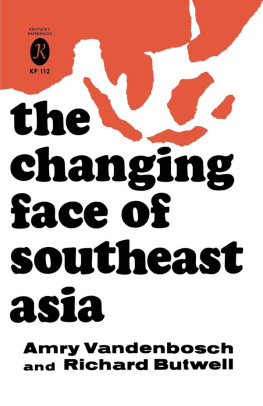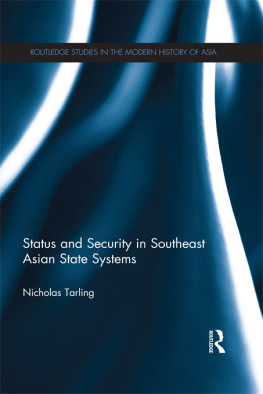SOUTHEAST ASIA
AMONG THE WORLD POWERS
AMRY VANDENBOSCH
and RICHARD BUTWELL
Reissued, with supplement, 1958
1957 BY THE UNIVERSITY OF KENTUCKY PRESS
PRINTED AT THE UNIVERSITY OF KENTUCKY
Library of Congress Catalog Card No. 57-9768
The publication of this book is possible partly because of a
grant from the Margaret Voorhies Haggin Trust established
in memory of her husband James Ben Ali Haggin
PREFACE
FIFTY YEARS AGO several areas of the globe were little touched by the main currents of world affairs. Others escaped involvement altogether in the rivalries of international politics. This era is no more. Today, the former colonial territories of Asia, Africa, and the Middle East comprise key arenas in which crucial struggles are taking place: struggles which could determine whether men will look back on the twentieth century as an age in which freedom flourished or was dealt a formidable setback.
One of these former colonial areas is Southeast Asia, the subject of this book. The eyes of an entire world seemed focused on Southeast Asia in the spring of 1954 when the French fortress of Dien Bien Phu fell to the Communist Viet Minh in once-remote Indochina. Most of these eyes were turned toward Southeast Asia for the first timebut probably not the last.
This book seeks to provide the reader with a brief yet comprehensive picture of this increasingly important region in the hope that he may understand more fully future developments in the lands which are Chinas southern neighbors. There are six chapters dealing individually with the countries comprising the area. Three other chapters offer a general introduction to the area, analyze the international relations of Southeast Asia, and describe the approach of American foreign policy toward the countries of this part of the world. A select and late bibliography is provided for the reader who will wish to examine further the past and the prospects of Southeast Asia.
An effort has been made to focus attention on major problems of the area and on recent important happenings. Because the events taking place in Southeast Asia at the present time are both swift and basic, the authors have sought to include significant developments right up to the eve of publication. The immense changes which were registered in Southeast Asia between 1939 and 1945 are continuing, and no work which fails to take cognizance of this fact can hope to offer a true picture of todays Southeast Asia.
The authors have drawn upon the writings of the increasing number of scholars who specialize in the governments and politics of the region; to them they owe a debt of gratitude. They have also drawn on their own published writings. Much of the subject matter of this work, however, is presented for the first time in book form here. It is based on the research and observations of the authors, both of whom have traveled recently in Southeast Asia. A considerable debt is owed to those who assisted them in meeting leaders and representative figures of the area.
The senior author wishes to acknowledge his indebtedness to the Social Science Research Council for a research fellowship and a travel grant which enabled him to visit the countries of the region in 1929-1930 and again in 1950 for the purpose of studying their governments and politics.
Mr. Butwell wishes to express his thanks to the United States Fulbright Program for providing him with the opportunity of two years of study of Southeast Asian international relations at St. Antonys College, Oxford University, and the Institute of Pacific Relations for a grant for travel in Southeast Asia in 1953.
AMRY VANDENBOSCH
RICHARD BUTWELL
The publishers wish to acknowledge with thanks the cooperation of the Institute of Pacific Relations in the distribution of this book.
CONTENTS
CHAPTER I
SOUTHEAST ASIA CONTEMPORARY POWER VACUUM
NOT SO LONG AGO the people of the Western world knew only vaguely of the existence of the countries of Southeast Asia. India, on the fringe of the region, had for several decades attracted a great deal of attention because of its heroic struggle for national independence under a very unusual leader. The Philippines were known to Americans, though in a superficial manner, because the United States had the responsibility for governing the islands. Their countrys respective Southeast Asian colonial holdings were likewise known in a general fashion to Englishmen, Frenchmen, and Dutchmen. As a whole, however, the people of the West knew little of the lands east of India and south of China.
Today the Western world is conscious of Southeast Asia and of its importance in world politics. The change in attitude began with the Japanese invasion of Southeast Asia during the Second World War, which dramatically emphasized the strategic importance of the region. Interest sharpened when the loss of China left to the free world only the fringes of the continent and the off-lying islands and insular countries. The fall of Dien Bien Phu, lending itself to colorful news coverage, caught virtually everyones attention; as a result of its successes in Vietnam, the Communist bloc now also had a foot squarely in a country known as the gateway to Southeast Asia.
If the Communists gain control of Southeast Asia, the West is now fully aware, India will be threatened and the strength of Australia will be partially neutralized. The free world cannot afford to lose any more territory or prestige in Asia.
A LITTLE-KNOWN REGION ENTERS WORLD POLITICS
Southeast Asia consists of Indonesia, Vietnam, the Philippines, Thailand, Burma, Cambodia, Laos, Malaya, and the British Borneo possessions. The total land area of the region exceeds 1,600,000 square miles, and because much of it is insular, it covers a large expanse of ocean. Southeast Asias significance in world politics is particularly due to its strategic location at the southeastern extremity of the great Asian land mass. A tropical extension of the continent, the region consists of a two-pronged peninsula on the mainland and a vast string of islands stretching along both sides of the equator for a greater distance than that between New York and San Francisco. The main sea route between the Pacific and Indian oceans passes through the area, which also serves as a link between Asia and Australia. With the important exception of northeastern Indochina, an extension of the south China littoral, Southeast Asias boundaries effectively separate it from the nearest land masses on all its sides. In the north, high mountains divide the region from China and Indiaexcept for the northeast coastal region of Vietnam in Indochina. Southeast Asia is bordered by water to the east, south, and west.
As a consequence of the events of the post-Second-World-War yearsand the headlines which chronicled themthe term Southeast Asia is now common in discussions about international political, social, and economic developments. Before the war, however, these tropical-equatorial lands were thought of almost exclusively as overseas extensions of the Western metropolitan powers which controlled their destinies. They had little political identity or significance apart from their colonial connections. Nor was there any reason why this should have been otherwise. As late as the nineteen-twenties and early thirties Southeast Asias was not a role of vital importance on the stage of international politics, although the area produced most of the worlds rubber and tin and more than two-thirds of the rice entering world trade.















